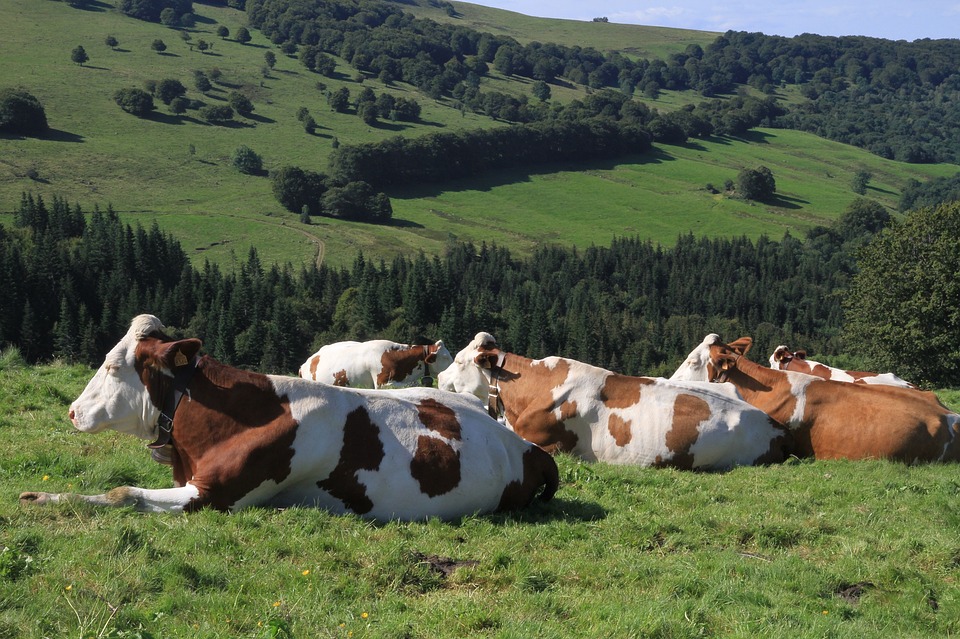How much do you know about the cows that feed you? Most people eat beef and drink milk, but the cows have to eat first. While most of us think of cows grazing in a field, the truth is most cows also depend on compounds mixed by farmers. What happens when a cow was grass-fed versus not and why are so many consumers demanding their cows be grass fed as opposed to the feeding trough?
Cereal grains unnaturally fatten up cows faster
All cows graze in the field. Their stomachs have several compartments that help them digest the grasses and those same plants provide cows with essential fibers. Those grasses don’t provide a high-energy food to help them grow and gain weight in a short amount of time. So, farmers reach for grains to fatten up their cattle.
A concentrate is a mix of cereal grains as well as the byproducts of harvesting those grains and fermenting them for alcohols. This means the concentrates may contain sorghum, barley, oats, wheat or corn and possibly soybean, cottonseed or peanut meal. Farmers use these concentrates to grow and fatten cows as quickly as possible, getting them ready for slaughter in only 14 months.
The problem is that cows evolved to eat grasses, not grains. Cows have something called rumen in their stomach, a digestive organ that can break down greenery far better than our own stomachs. It makes more sense for cows to be grass fed when it comes to their health, but profit-driven farms want results fast, not naturally.
Too much of a grain concentrate can cause a stomach problem known as acidosis. This is the feeling you get when you eat too much sugar or starch-heavy foods, (think fast food hangover), and can make the cows unwell. It’s the farmer’s job to make sure that the cows are getting a mix of different feeds to keep the cow’s stomach balanced and the cow growing.
Some farmers are challenging this status quo and producing meat and dairy that is grass fed only.
Why Grass Fed Dairy is Best
When a cow classifies as grass fed, it refers to a diet that comprises many different greens. Clover, onion greens, soft wild leaves all factor into the genre known as grass. This helps keep the balance in the cow’s stomach without the concentrate and keeps the cows moving, turning them into living lawnmowers.
A few things happen when cows are grass-fed only. First, their milk becomes much richer in Omega-3s. Grass fed dairy is also full of Conjugated Linoleic Acids, (CLAs), which are wonderful for blood sugar regulation, brain health and building bone marrow. They also help with keeping off extra weight and improving your heart health. In an 8-ounce serving of grass-fed milk you will get 75 milligrams of CLAs and get off to a great start.
Grass-fed milk has saturated fat, but that’s not bad news. About 6-7% of the saturated fat in grass-fed milk is short-chain or probiotic, making it very good for your gut health. About 50% of the saturated fat in the same glass of grass fed milk is medium chain, the same kind you find in your coconut oil. It also contains a small amount of monounsaturated fat, (like avocados and olive oil), which helps your body burn calories.
How to Find the Real Thing
There are some great tools to guide you in your search for grass-fed milk, butter and cheese. First, you can check Real Milk, a state-by-state guide that helps consumers spot the best places to shop. The Weston A. Price Foundation also offers additional food studies by state. Their goal is to empower shoppers with as much information as possible about the foods they buy, dairy included.
Finally, you can visit your local farmer’s market and talk to the farmers in your area about what they offer and why. The more you learn about your milk, the better. You should feel confident you’re getting the best quality possible and a local farmer can point you in the right direction in getting some high quality grass-fed dairy.
